#vodou mythology
Text
Deadly fall: Baron Samedi
BARON SAMEDI
Category: Vodou religion
Baron Samedi (which is French for “Baron Saturday”) is without a doubt one of the most famous figures of the Vodou religion, but do you actually really know who he is? Popular media keeps using and reusing his name and appearance for everything and anything. Let’s take a look at the Baron’s real identity.
Already one popular misunderstanding is that Baron Samedi is not a god. In the Vodou religion that is only one God, the big G true God that made the world and rules over it. Baron Samedi is part of a group of powerful spirits known as the “loa”, mistaken for the “gods” of Vodou because they receive sacrifices and are at the center of rituals. While they all were inspired by gods of African cultures, in the Vodou religion they are rather entities half-way between saints and spirits that act as intermediaries between the human beings and the real big G God (Bondyé).
Baron Samedi is the loa of the dead : he is the head and leader of an entire “family” of loa called the Guédé, who are the spirits of death and fertility, lust and morbidity, forces associated with the passing into the afterlife, the ancestor worship, and the guarding of history and heritages. Baron Samedi himself is a force of death usually roaming between the world of the living and the one of the dead: he welcomes the souls that arrive in the underworld and acts as the master of the dead. He is the one that makes sure all the corpses rot so that nobody can bring them back as zombies, he can be met at cemetery crossroads and it is said that the oldest grave of a male deceased in a cemetery is dedicated to him (people put special crosses or a black top hat on it to consecrate the grave as the Baron Samedi’s grave).
But Baron Samedi is not just a force of death, as everyone presumes. The whole point of the Guede, as I said earlier, is that they mix the forces of life and death in one bizarre package, and as a result Baron Samedi, master of the dead, is also the giver of life. He is a loa of resurrection who is often called to help those that are dying or near death, to offer protection or healing: for you see, only the Baron Samedi can accept someone into the afterlife, by “digging their grave”, and so if he refuses to dig someone’s grave for one reason or another, this person won’t die. That’s how, by making offerings to or making deals with the Baron, you can heal grave wounds or cure mortal diseases: his powers are so great he can undo curses and fight off evil magic. What is offered to appease, please or thank the Baron Samedi range from cigar and rum to black coffee and grilled peanuts; but of course nothing beats a good “riding” ceremony where humans offer themselves as “rides” to allow the loa to enter the human world through their bodies (a sort of holy possession ritual).
Baron Samedi has two great loves in life (beyond his own wife, Maman Brigitte, another loa of the dead) : alcohol and tobacco. The Baron is always seen with either a cigar in his mouth, or a cup of rum in his hand, or both! He is known to be a quite obscene spirit that constantly swears and loves to make filthy jokes, and while he is married, he still doesn’t hesitate to seduce or chase down human women for sweet and passionate love. In terms of appearance, the Baron Samedi originally was depicted as a living, talking, moving skeleton – though with popular culture and media adaptations it became common to depict him as a black man with a skull painted on his face). He wears a top hat, a tail coat and sunglasses (all black, of course), plus cotton plugs in his nostrils: this whole outfit is actually an evocation and a mimic of the way male corpses are prepared for funerals in Haiti. Whenever he speaks, it is with a nasal voice.
As I said before, Baron Samedi has a family; his lovely wife is Maman Brigitte, a female and foul-mouthed loa of death often appearing as a white woman ; and together they have an adoptive son, Guede Nibo. Once he was a handsome young human man, but after his brutal murder his spirit was adopted by the loas of death – he is now a leader of the dead and a great healer like his father, appearing as black-dressed, effeminate dandy, or even as a nasal-voiced, lascivious cross-dresser. There are also, among the Guédé family, several other “Barons” that are either Baron Samedi’s brothers, either minor incarnations of him – sometimes they’re colleagues, sometimes they’re the same. The three most notorious of them are Baron Cimetière (Baron Cemetery, guardian of cemeteries and protector of graves), Baron La Croix (Baron The Cross, a more suave and sophisticated version of Samedi who is prone to philosophizing about death) and Baron Criminel (Baron Criminal, who is the dreaded spirit of the first murderer to have ever been sentenced to death).
- - - - - - - - -
For a more sinister and less funny bit of trivia… Baron Samedi is an integral and prominent part of the Haitian Vodou (before it spread elsewhere, like in Louisiana and the like). And he is also tied to the grim political history of Haiti. One of the most infamous names of Haiti’s history is François Duvalier (aka “Papa Doc”), who started out as the elected president of Haiti in the late 50s, but quickly became an oppressive and tyrannical leader using many dictatorial elements ranging from death squads to personality cults. Said personality cult heavily included elements from Haitian folklore, mythology and religion – and one figure Papa Doc especially liked was Baron Samedi. He uses subtle elements to make himself quite similar to the Baron – the two most notably being that he wore dark glasses and spoke with a nasal voice during public speeches and important appearances.
Now Duvalier is long dead, and the Duvalier regime, while outlasting Papa Doc through his son, the just as feared and reviled Jean-Claude Duvalier, is over – but the “President for Life”’s connection to the Baron Samedi left its mark, and as a result even today the Baron Samedi is seen, perceived and used in the context of “secret societies” and the shadiness of politics.
28 notes
·
View notes
Text



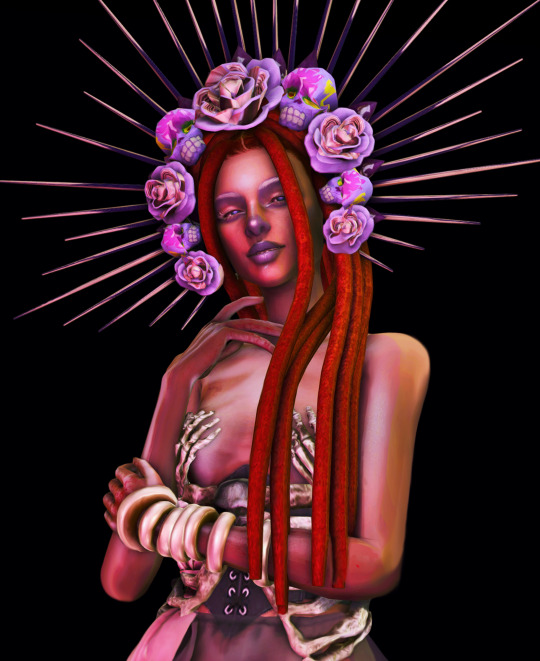

Promt: Voodoo Doll 📍💀
Baron Samedi & Maman Brigitte 💜
#the sims 4#sims 4#vodou#ts4 occult#simstober#simblreen#sims 4 halloween#llamafrightscas#ts4 cas challenge#baron samedi#maman brigitte#SimsHorrorween#sims 4 folklore#sims 4 spellcaster#bobaween#sims 4 mythology#maadhalloween#sims 4 grim reaper
228 notes
·
View notes
Text
Brigit/Brigitte goddess of healing & smithing!

So im not only obssesed with Norse mythology but Celtic and Haitian Vodou as well! And i have a headcannon regarding those two.
Since its said Maman Brigitte was adopted into the loa famliy and depending on who you ask she is a white/mixed/black woman. Well what if she used to be the same as Brigit, the celtic goddess?
I recall there being one myth where Brigit had turned into a fish and she was later captured, drained of her magic and killed.
What if, in the after life she got lost and couldnt remember who she was and then the Loa found her and takes her in! Later she gets married to Baron Samdhi and they adopt a son together, who Brigitte is very attatched to without realizing its because she used to have a son! (spoiler: he got killed in one myth when his father sent him to spy and kill a very powerful smith..OOF)
I also would like to headcannon that since Artio's parentage wasnt written down, that was because she was secretly Brigit and Cernunnos's daugther! But after Brigit went missing Cernunnos let Dagda adopt her, since our guy Cernunnos is a busy man and Dagda so would!!
I mean to disrespect to anyone who worships Maman Brigitte and Brigit sepretly! This is all just for fun!!
Have Brigit with her two children when she was alive! <3
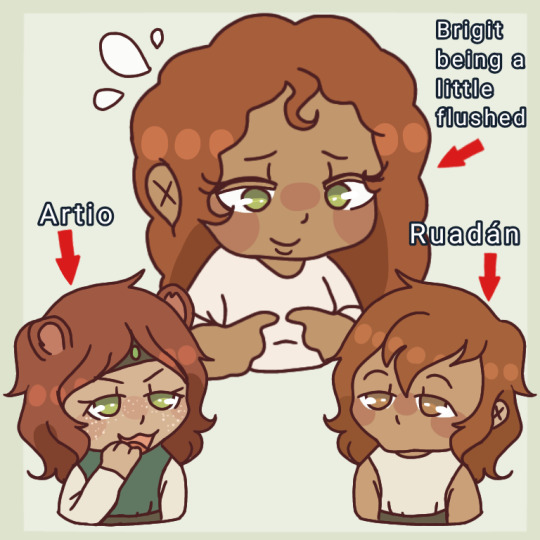
#celtic mythology#haitian vodou#maman brigitte#brigit#brigitte#artio#Ruadán#headcannons#goddess brigid
7 notes
·
View notes
Text
I need a break from my usual posts, so have this thought experiment instead
I'm curious as to why every time a cartoon chooses to focus on using either divine figure or mythological monsters as characters or a plot element, they choose either Greek/Roman, Chinese, Japanese, Norse, or Egyptian as if those stories haven't already been told via cartoon, movie, or comics hundreds of times already. Not that I dislike this is any way, but I'm wonder that why in an era where diversity and uniqueness are paramount in media, why has nobody picked up other pantheons of deities to make shows about?
How about a cartoon where two Irish siblings invoke a spell left to them by their grandmother that accidentally resurrects the demigod warrior Cu Chulainn? Now you have an ancient symbol of Irish culture trying to adjust to the modern era all whilst protecting two disfunction kids from the myriad of cryptids their spell also awakened.
Or how about a Haitian girl who lives in New Orleans striking a deal with a god in order to impress the guy she loves? After she pays back her debt in full, she finds out that, since mortals have been historically terrible at paying off debts while alive, her soul has already been auctioned off to an unknown spirit. You now have a teenager searching the spirit realms with Baron Samedi and Maman Brigette for the Lwa who holds her contract.
How about a Hawaiian native teenager who finds out he is the demigod son of Pele? Cool as this sounds, his aunt Nāmaka does not allow him to leave the island and constantly sends monsters from the sea after him thinking he will wake up his mother and destroy the island. Demigod teen ends up caught in the middle of a centuries long family feud and has to piece his godly family back together.
What about a Māori girl who discovers she is the descendant of Kupe? When a plague ravages her home, she is forced to repeat Kupe's grand voyage, taking her to all matter of mystical and magical islands in order to find the cure.
Or what about a teenage girl from India who, while reciting the Ramayana, brings Rama and Hanuman to life in her hometown? She now helps Rama and Hanuman search for lady Sita and fight off Ravana's armies who are searching for her as well.
#story prompt#greek mythology#norse mythology#mythology#egyptian mythology#haitian vodou#hawaiian mythology#irish mythology#hindu mythology#Polynesian mythology#cartoon idea#diversity
15 notes
·
View notes
Text
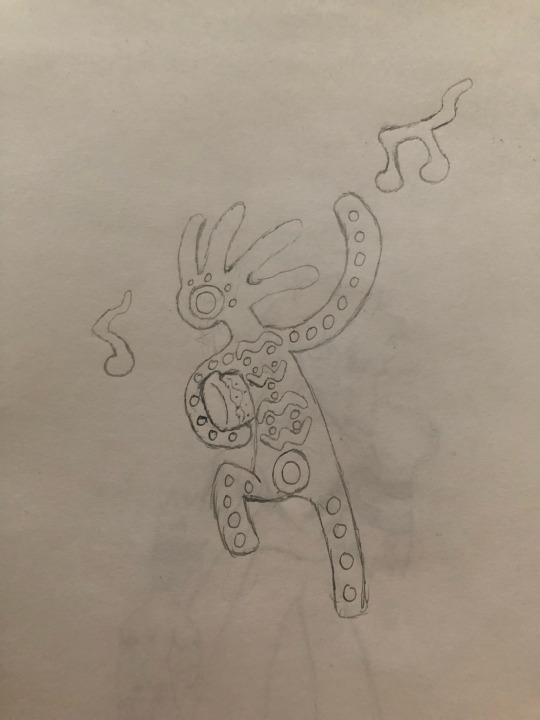
Joyboy, the Vodou spirit of hope and music, whoever hears the beat of his drum cannot resist the temptation to dance and laugh their worries away.
8 notes
·
View notes
Text
Congolese food of the day:
Chikwangue; It’s made from cassava, which is fermented and packed in banana leaves

#congolese#dr congo#congo mythology#food#congolese food#congolese mythology#democratic republic of the congo#african mythology#african food#congo#hoodoo#voodoo#vodou
9 notes
·
View notes
Photo

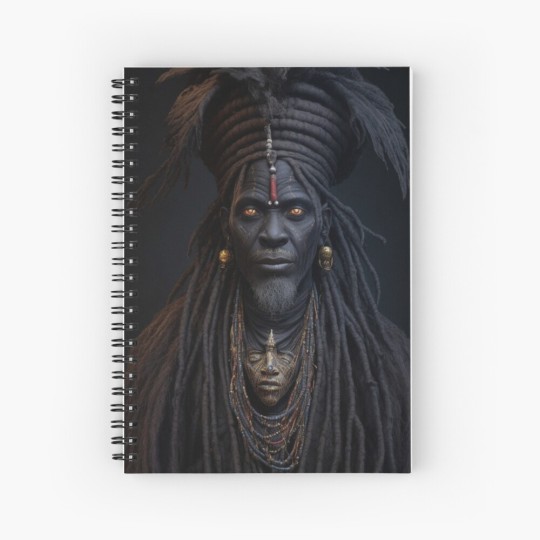
(via Papa Legba Spiral Notebook by Rothnaric)
My New West African Voodoo Lwa / Loa Collection
Papa Legba (more available in my Redbubble shop) Get my art printed on awesome products. Support me at Redbubble
Rothnaric.redbubble.com
#findyourthing#redbubble#papa legba#voodoo#vodun#design#digital portrait#stickers#notebook#loa#lwa#african mythology#haitian vodou#spiritual art#art prints#home decor#tshirt#t-shirt#unique gifts#african gods#voodou#Rothnaric
0 notes
Text
#polls#mythology#egyptian mythology#hindu mythology#japanese mythology#norse mythology#haitian vodou#slavic mythology#mesopotamian mythology#aztec mythology#philippine mythology
1 note
·
View note
Text
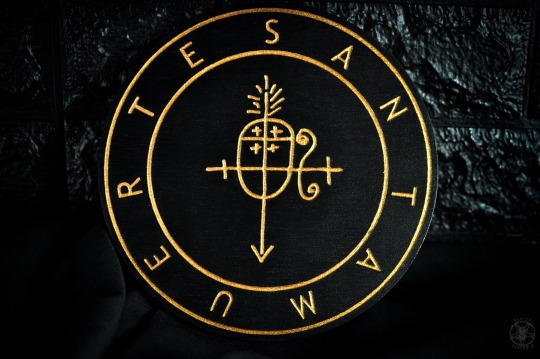

Image ID: First image: a "veve" of La Santa Muerte. Second image The same "veve" but with the "no" sign superimposed. End Image ID
If you involved in El Culto a la Santa Muerte in any sort of way, chances are that you may have seen this "sigil" online and being sold on places like etsy
It is fake and cultural appropriation. Do not use
The "sigil" you see here is supposed to be a veve, a religious symbol used in Haitian Vodou to represent a specific Lwa (at least according to Wikipedia). Santa Muerte is not a Lwa; she is a Mexican Catholic folk saint. She does not have veve
Now while there is a theory that an ATR may have influenced the creation of El Culto a la Santa Muerte, the ATR is question is Santería, not Haitian Vodou. To my knowledge, Santería does not use veves
Further digging into the origins of this fake veve revealed that it was allegedly made up in 2012 by someone attempting to demonize both El Culto and Haitian Vodou
Unfortunately, as El Culto grows in popularity and more and more people ignore pleas and warnings from traditional Mexican Muerteros to not separate Santa Muerte from Mexican culture and Catholicism, this sort of thing will occur more often
It is important that followers and allies, particularly white followers and allies, do their research and prevent this sort of thing from spreading. If you are not Mexican, this includes doing research on Mexican culture and Brujería. This is not permission to appropriate Mexican culture or Brujería. If you are not Catholic, research on Catholicism. I would also recommend doing research on Aztec and Maya Mythology, Santería, and El Culto al San Pascualito Rey as these are all believed to have directly influenced El Culto a la Santa Muerte. Once again, this not permission to appropriate closed practices
Also important is to listen to traditional Mexican Muerteros. Traditional Mexican Muerteros have stated countless times that El Culto a la Santa Muerte cannot be divorced from Mexican culture or Catholicism and should not be combined with other religions (And please do not try to use Indigenous Mexicans syncretizing the veneration of Santa Muerte with the worship of Mictecacihuatl or other Indigenous Mexican goddesses as a counter example. That is not the same thing).
tl;dr: This "veve" is culturally appropriative bullshit and should not be used by followers or devotees of la Santa Muerte
28 notes
·
View notes
Note
Do you think there’s a meaningful distinction between “witches” and other magic users in the marvel universe (beyond, potentially, gender)?
Witch and warlock are obviously treated more or less as gender-swapped synonyms and both have somewhat negative connotations that don’t get associated with people like Dr Strange (afaik), but I feel like there might be more to it, I’m just not sure. Calling Nico or Billy a witch feels more accurate than calling Cleo or Victor a witch, but I can’t figure out if this is grounded in anything besides my own opinion
Yes, actually! We can identify social, cultural, mythical and practical factors distinguishing "witches" from other types of magicians. However, those distinctions are not always clear. As you noted, the word "witch" is often used very broadly to describe any female spellcaster. As a reader, you'll have to rely on context to determine whether the writer is denoting a specific type of magician, or just using gendered language.
Functionally speaking, all forms of magic are basically interchangeable. Most spellcasters have the same powers and abilities, and writers don't always put in the effort to make them feel unique. That doesn't necessarily bother me, so long as they are tailoring the language and imagery to suit each character's background, but that doesn't happen as often as I'd like. Again, you'll just need to use critical thinking to figure out when a lack of distinction is really just a lack of creativity and effort.
With that out of the way, let's break down what we do know about witchcraft, and the history of witches, in the Marvel world!

Social: Witches have historically gathered in covens, settlements and societies, and have even endured literal witch-hunts. In real life, this is not quite the truth, but it Marvel comics, we can say that witches comprise distinct societies which suffer distinct forms of persecution. We also know that many witches belong to a magical lineage, and that these witch families often use a special naming convention to identify themselves with unique colors and symbols, indicating that witches have unique customs and traditions setting them apart.
Cultural: In Marvel comics, all forms of magical or spiritual folk practice are literally real, in the same way that all mythologies and polytheistic religions are literally real-- Asgard is a real place, Thor is a real person, and spells have real power. Witchcraft is typically represented as a form of European folk magic. Other traditions, such as vodou, voodoo, and multiple forms of Indigenous spirituality have also been demonstrated, and are often grouped together, along with witchcraft, under a broad category of "cultural magic." As shown in Midnight Suns, many of these traditions from around the world have a certain shared history, as the Coven at Mount Wundagore included representatives from numerous cultures.
Mythological: "Witchcraft" itself exists as an abstract entity, like Death, Nightmare, or Eternity. She is the source of witchcraft's power, but also a symbolic representation of all witches and the natural balance of magic, and she is sometimes worshipped as a goddess. Witchcraft resides at the heart of the Witches' Road, an Inner Plane uniquely accessible to witches that transcends time and is connected to many of the mythical realms. Witchcraft may also be intrinsically connected to chaos magic-- ancient witches were responsible for binding and harnessing Earth's natural chaos magic; Witchcraft, the entity, is shown consorting with an abstract Chaos entity; and we know that Wundagore and the Darkhold are connected to many cults and covens throughout history.
Practical: Unfortunately, this is the weakest area. For a brief time, Wanda's magical practice borrowed a lot of Wiccan motifs, which was problematic in its own right, but in modern comics, we just don't get to see enough of how witches, specifically, do magic. Most characters who practice some form of traditional magic have a closer connection to natural elements and the spirit world, and they may have particular powers related to their background. Doctor Voodoo is a great example, although the actual depiction of his culture is deeply flawed. Scarlet Witch (2015) introduced certain unique abilities, such as witches' sight; specific mechanics around the cost of magic; and a style of spellcasting that relied on Wanda's knowledge of real-world languages and magical symbols. Billy and Nico also use varying degrees of wordplay, so I like this approach and I would focus on building that into a cohesive magical system if I was a writer.
#wanda maximoff#scarlet witch#agatha harkness#billy kaplan#wiccan#nico minoru#jericho drumm#witchcraft#magical theory
34 notes
·
View notes
Text
Deadly fall: Masterpost (1)
Opening
Greek mythology: Macaria, Charon, Thanatos, Hades and some underworld geography
Chinese mythology: Yanluowang, Zhongyuan Jie
Vodou: Baron Samedi, zombies and the Guédés
Norse mythology: Hel and Garm
Allhallowtide: All Hallows Day, el Dia de los Muertos, Samhain, Halloween, plus the “other Halloweens”
Egypt: Anubis, the mummy’s curse, and the curse of the Luxor
Abrahamic religions: Ghouls (Arabian folklore), Azrael (Abrahamic religions), Limbo (Christian belief)
Shared by various cultures of the world: Necromancy (from Greco-roman mythology to the biblical Middle-Ages), the Grim Reaper (from European art to Southern American religion), the Headless Horseman (from European folklore to American literature)
Other: The Ankou and more about the Ankou and even more about the Ankou (Breton folklore), Yama (Hindu mythology), the Parcae (Roman mythology)
#deadly fall#masterpost#ghosts#hauntings#afterlife#underworld#greek mythology#norse mythology#vodou#chinese mythology#allhallowtide#halloween#psychopomp#death#grim reaper
32 notes
·
View notes
Text

Rainbow Spirits
Through many cultures the rainbow is something magical and sacred. These are some of the deities and spirits associated with the rainbow
Manzat: Mesopotamian and Elamite Goddess who was the personification of the rainbow
Iris: Greek Goddess who personifies the rainbow, or in other myths, the rainbow is the path she travels as the delivers messages from the Gods to the human realm
Rainbow Serpent: Aboriginal Australian Creator god who also controlled the rain
Hong: Chinese two-headed Dragon who represents the rainbow
Ix Chel: Mesoamerican Goddess of rain, birth, and healing. Chel means rainbow.
Anuenue: Hawaiian messenger Goddess to her brothers, Tane and Kanaloa. She is the Rainbow Maiden.
Oxumare: Yoruba Orisha who is the personification of the rainbow.
Ayida-Weddo: Haitian Vodou Loa who is the personification of the rainbow
Dan: West African Vodun spirit who is represented as a rainbow serpent. Dan is the androgynous son of Mawu, the Divine Creator, and acts as a mediator between the spirits and the living.
Uenuku and Kahukura: Māori atua's and prominent ancestors, both of which are personifications of the rainbow, and usually represent omens.
Cuchavira: Meaning "shining air", she is the personification of the rainbow and protectress of working women and the ill for the Muisca, the indigenous people of the highlands in the Andes.
Amitolane: Rainbow spirit from the mythology of the Zuni, a Native American tribe.
Prende: Albanian Goddess of the dawn, love, beauty, fertility and health. Her belt was said to be the rainbow.
Indra: Hindu God who is the King of the devas and Svarga. He is a God of the sky, lightning, weather, thunder, storm, rain, and war. In Sanskit the rainbow is called the "indradhanus" or the Bow of Indra.
Rama: Hindu hero-king who was the seventh avatar of the God Vishny in the Vaisnava tradition. A Bengali word for rainbow is "rongdhonu", meaning Rama's Bow
Rainbow Prince: French fairytale prince who can only speak when there is a rainbow
Christian God: After the devastating flood that killed all life except for fish and the animals and people on Noah's Ark, God made a promise to never again destroy all life in this way. He gave Earth the rainbow as a symbol of this covenant.
Leprechaun: being from Irish myth that is sometimes classed as one of the Aos Sí. The leprechaun was thought to guard the pot of gold at the end of the rainbow.
Unicorn: A new link between the mythical unicorn and rainbows has been forged, where these have become almost inseparable. It is unsure where this first started. Unicorns symbolize purity, blessing, healing, and freedom.
[Part of a Rainbowmancy series, masterpost here]
#rainbowmancy#rainbow magic#rainbow witch#deity#rainbow#magic#spirits#unicorn magic#witch#witchcraft#witchblr#paganblr#symbolism#mine#personal
11 notes
·
View notes
Text
Voiceplay Visuals: Queen In 5 Minutes
This is one of those videos where I'm gonna have to remind myself to not talk about the music, because Queen is awesome, I know quite a decent amount of their songs, and this arrangement/performance is really freaking good. But the video itself certainly isn't boring either (Freddie would be proud), and I'm very excited to talk about this one, so let's go! (Yeah this one's a long one, you have been warned)

Apparently this video (released on the 24th of November, 2018) was at least in part inspired by a health scare that Earl had while touring with Voiceplay, which no doubt was very distressing for all of them, but he obviously was fine or got better, which I'm glad about, and this video is creative as heck!

Won't talk about their appearances just yet, but of course I gotta point out the iconic Bohemian Rhapsody diamond configuration thing!

Cool necklace! I don't know the exact meaning of it, and whether or not it was just acquired for the video, but I do know that the album/track image for this cover on Spotify takes inspiration from it!
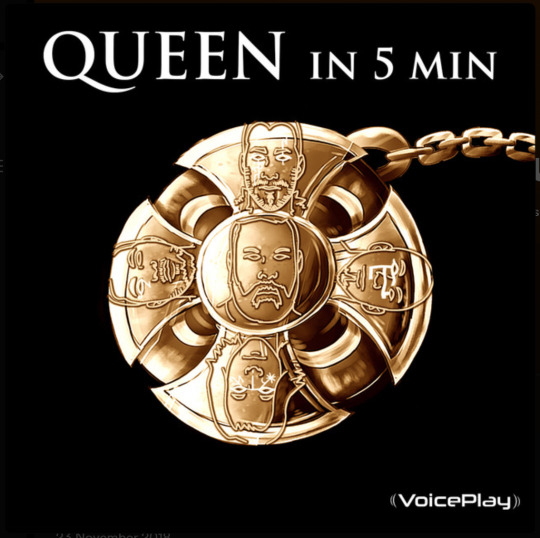
(Also this song is split into two parts on music streaming platforms, idk why)
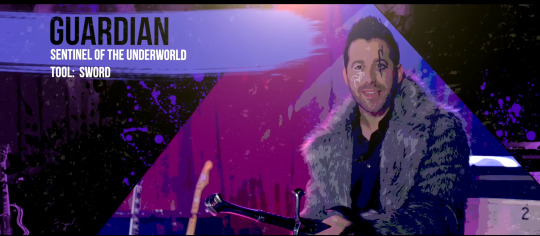
*(clapping my hands together)* character time!
I have no clue what mythological being Layne's character is meant to be based off of, if any - "Guardian" is a bit of a vague name after all - and the main thing that popped up when I typed "mythology sentinel of the underworld" into Google was Cerberus, the three-headed guard dog from Ancient Greek myths. And well... it'd check out actually. Layne doesn't talk/sing in this video (not counting vocal percussion of course), he's wearing a big furry grey coat, and none of the other 3 are from Greek (or even Roman) mythology, so it's entirely possible that "Guardian" could just be a human-form Cerberus (minus the two extra heads).
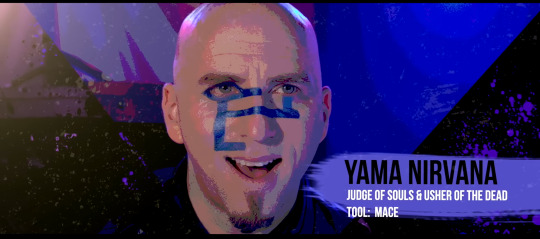
Apparently "Yama" is the Hindu god of death and justice, though he was also adopted into Buddhist, Chinese, Tibetan, Korean, and Japanese mythology as the king of hell, so-
A 19th-century painting of Yama on his mount depicts him as completely blue, so Eli's blue face paint definitely fits.
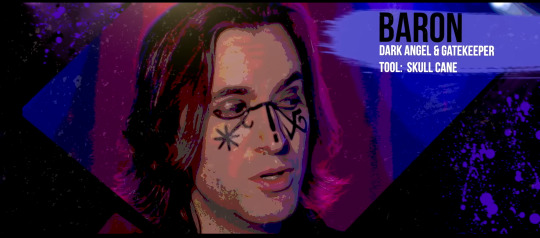
("Dark angel" definitely sounds fitting)
Geoff is based on Baron Samedi, who is a spirit (Iwa) of the dead in Haitian Vodou, as well as of course the more well-known Louisiana/New Orleans Voodoo. Fun fact: Dr Facilier in The Princess And The Frog is partly inspired by Baron Samedi!
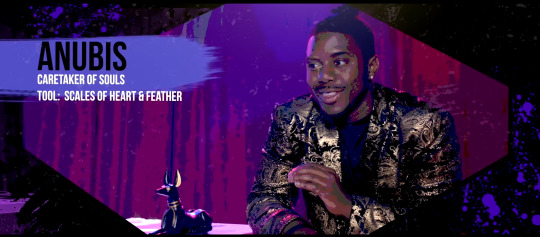
I'm sure most if not all of us have heard of Anubis, but regardless, Anubis is the Ancient Egyptian god of funerary rites, and he's also a protector of graves, and of course, a guide to the underworld. He can take both human and animal form, and in artwork is often depicted with the body of a man and head of a jackal/canine animal (which Voiceplay subtly refers to in this shot here with the little Anubis Shrine statue sitting next to J)

Cool and Normal! 😆
(Also really love that jacket/blazer)

"Anubis" is of course weighing Earl's heart against a feather to see whether or not he is worthy of ascending to the heavenly afterlife. And since the heart appears to be slightly lighter, he's good! (Not that he's actually ready to pass on, though)
(Also, from a production viewpoint, I'm guessing they had some small stones or counterweights hiding underneath the feather?)

...Not gonna say anything, just putting this here

Love how "Baron" glances at his cane as if to check for any dirt or smudges from Earl 😆
(Geoff still has that cane I believe; when he did a few Q&A/"how to sing low" videos on his channel back in 2020, the cane was just chilling in the background, behind where he was sitting in his home office/workspace)
(Also obligatory he's so handsome/pretty aaaaaaa)

The body language of "Anubis" here when Baron starts talking (i.e. when Geoff starts singing), and the way that he, "Yama", and "Guardian" are all at one end of the stage, while "Baron" is on the other, says so much in such a small way! (Geoff once again getting to be Special(tm), love that for him)

"I've done my sentence, but committed no criiiiiiime!"

Cool necklace! (Also really love the subtle red edging/trim on his blazer/coat, very cool and gives me Crowley vibes)
While I'm talking about Geoff, time for another hair study!

(This one I actually used separate screencaps for the outline and for the colour grabs)

Wasn't even trying to pause in this shot but pfft Eli/Yama and J/Anubis doing the 🤏 thing
(Also kinda sorta another Eli Eyebrow raise?)
Baron: *(evil laugh)*
Anubis: OHKAY it's getting a little tense in here, time to lighten the mood a little bit!
Baron: wow rude
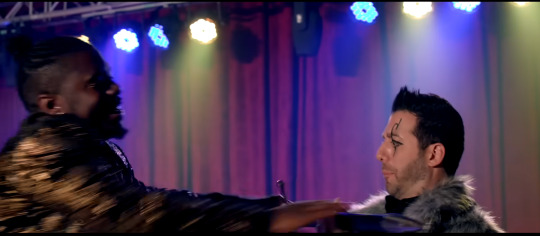
Anubis: here hold this for me thanks!
Guardian: wait what am I meant to do with this?
(Though I'm pretty sure that's meant to be his sword anyway?)
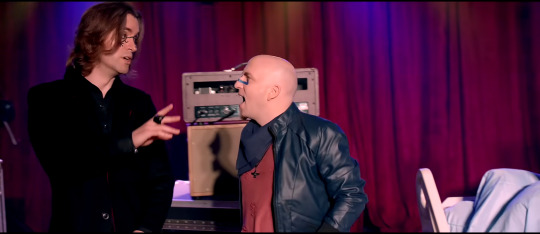

"Nooo time for looosers"
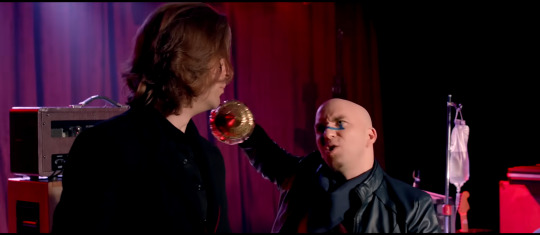
Fight! Fight! Fight! (Eli/Yama: "I'm three ounces of whoop-ass")

Love the facial expressions here, Anubis/J looks like he half-wishes he had popcorn! 😂

Thumbnail moment! (Or close enough anyway)
Yama singing "I don't need you" to Baron and Baron doing a sort of sarcastic "haha very funny" head motion in return, love it
Not talking about the arrangement but I'd like to thank the Good Omens fandom, because I wouldn't have recognized/known the bridge of Good Old Fashioned Lover Boy in this medley otherwise (I didn't first see this video until like a year or so after it first came out)

If you ever wind up in hospital, don't actually try to rip out IV drips or cannulas or any other tubes connected to your body!

If I had a nickel for every time a different member of Voiceplay played air guitar in a video, I'd have at least four nickels! (Earl here, Cesar in Hellfire, Eli in Top 10 Sitcom Themes, and Geoff in at least three or more videos (maybe 5 if we count J None in the Frozen 2 Medley))

Full-body group shot! (Also Eli, those shorts and those shoes are... an interesting combination that's for sure 😅) Also check out the body language of Baron/Geoff and Guardian/Layne!
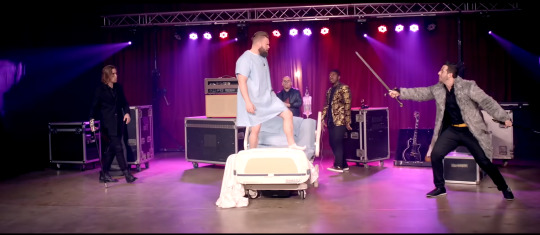
There's a comment or two that sums up "Guardian's" body language as "I don't actually want to hurt you, but I will if I absolutely have to"

Love "Yama's" expression right before he's turned into a puff of smoke 😆

Baron was on Earl's side the whole time!

It would have been cool to have Baron bow out himself and be like "you did well, you can go on living now", rather than being poofed away like the others, but eh I'm sure Voiceplay had their reasonings
I would post a pic of the final shot, but Tumblr isn't letting me (I'm guessing I hit an image limit, rip). But still, it's very cute and sweet.
There's a reason why so many people adore this video/cover. The arrangement is stunning, the vocals are great, the costumes are cool, the makeup is really well done, and the whole plot/direction of the video is such a creative and original concept! Shoutout to Layne and Eli, who were in charge of both the video and the arrangement!
#voiceplay#acapella#queen medley#queen in 5 minutes#geoff castellucci#eli jacobson#layne stein#j none#earl elkins jr#earl elkins#acaplaya analysis#voiceplay visuals
8 notes
·
View notes
Text
Rainbows
A common motif in mythologies across the world is to zoomorphize the rainbow as a serpent or dragon. Examples of this include:
The Balaur is said to travel along rainbows, or in Romania the rainbow itself is a two-headed Balaur.
In parts of Ukraine, the Rainbow is called tsmok, a common term for Slavic Dragons. It drinks water from the ground and transports it into the sky, where it becomes rain.
Hong is a Chinese Word for Rainbow, which is depicted as a dragon with a head on either end. This term, as well as the other two words for rainbow: didong and ni, all contain Radical 142, a radical associated in the Chinese language with insects, reptiles, and dragons.
Ayida-Weddo is a snake loa found in Vodou, which is associated with, among other things, Rainbows. This loa is connected to a similar figure found in West African mythology, who holds the world in their coils.
Aboriginal Australian mythology has a wide range of Rainbow Serpent deities and entities.
79 notes
·
View notes
Text
Congolese food of the day: Pondu
Ingredients:
Cassava leaves
Onion
Green onion
Green pepper
Eggplant
Optional: sardine or mackarel
Recipe: crush the cassava leaves and add to a pot on low heat. Chop your veggies and add to the pot with water, still on low heat and leave until water is mostly gone

#congo#congolese mythology#congo mythology#dr congo#democratic republic of the congo#african mythology#voodoo#vodou#hoodoo#congolese#food#foodie#congolese food#african food#folklore
5 notes
·
View notes
Text
travel rambling!! under the cut!! because I do intend to ramble!! a lot!!
like if you thought that wwdits was a hyperfixation of mine, you've never heard me talk about some of the religious traditions I've studied. lmao
SO first of all, religious syncretism is when elements of two or more religions/traditions are incorporated into religious practice. A crossover episode, if you will, and I am obsessed with it. When I was in college studying religions and folklore, it quickly became a driving force in my intellectual curiosity.
I've always been really interested in how people pick and choose from different traditions to create their own personal belief systems, and syncretic religions can be this on a micro or macro level. We could be talking about something as individualized as a self-identified pagan assembling a collection of beliefs and rituals from various world mythologies and written/online sources, or we could be talking about something as established as Louisiana Voodoo, which is a syncretic religion with strong influences from Roman Catholicism, various West African religions, and Haitian Vodou.
Syncretic religions form in a lot of ways... immigration, colonialism, natural spread of tradition, purposeful assemblage of disparate ideas, etc. Sometimes there's a history of blood, sometimes a history of love, sometimes a little bit of both. And man, I feel like there's just something so human about it.
The thing I love best about stories is the way they grow and change within us. When you hear a story, you resonate with certain parts of it. You remember some parts best. And when you retell that story, you can't help but imbue it with a little bit of your own self. The parts you loved and the parts you hated and the parts you want to emphasize or deemphasize or embellish. You can't hear a story without taking it into yourself, and you can't tell one without making it your own -- even if you retell it word for word.
And I guess religious syncretism is the final form of that, a little bit? Taking ingredients from every part of your life, real and imagined and studied and genetic, and mixing them together into the precise stew that nourishes you best, either on an individualized or communal level.
I digress.
I started out with Egyptology in school, abandoned that for several reasons, and realized what I really loved learning about was religion, especially on a practical and/or vernacular level. (i.e. what people actually do rather than the ur version of whatever philosophy we're talking about.) Then Some Stuff Happened and I added on East Asian Languages and Civilizations and really started leaning into learning about Japanese folklore and religions, especially once I started studying in Kyoto.
When I was studying in Japan, I really wanted to learn a lot about Shinto. The concepts behind it had been kind of ill-defined for me, and I wanted to really nail down what people were even talking about when they talked about Shinto. But... to my surprise, even the Japanese people I talked to were really vague on the subject. Which made sense, I guess, as I learned more about it.
I was really, really lucky, actually, because a professor who knew quite a lot about Shinto came to teach at my (American) school shortly before I graduated. It's not easy to find good classes on that subject in the US, especially outside of the west coast and Hawaii. But we had a whole symposium where experts from all over the world came and discussed various research projects on the subject and I was So Happy. lmao
I'm not... gonna get too into Shinto right now. My final assignment for that class, IIRC, was to write a 15 (20?) page paper on the topic "what is Shinto?" so that... might give you an idea of how complicated the question is. lmao.
Suffice it to say, for now, that Shinto is a name that we've retroactively applied to a series of disparate practices and belief systems in what would eventually become Japan. So... in that respect, it's an indigenous religion of Japan, or at least a modern understanding of many of them.
(People think of Japan as one cohesive country because it is now, but maybe think of that period as being more like Ancient Greece? Lots of small little villages and towns (think city-states) that were separated by topographical features and therefore had their own cultures before they were unified into the country we know of as Japan much later.)
Shinto, as a modern concept... ugh, it's still super complicated. There are deities or spirits called kami, and there are several big, important ones like Amaterasu and Susanoo, but also there's just this thought that almost everything can contain a kami because everything has a spirit. (It's animism, baby.) So there is a spirit of that big boulder, a spirit of that mountain, a spirit of that tree, and they're all kami. There are literally thousands of kinds of kami, and they're everywhere at all times. People can become kami after they die, man-made objects can become kami. (Sort of Velveteen Rabbit style.) And in Shinto shrines, these kami are enshrined and venerated and kept happy. Like any deity, they can help or they can hurt, y'know?
There's... a lot more to it than that, some of it extremely political, but that's the essence of it, I think. Kami veneration. (What that entails is... debatable, too! haha)
God, and that was my short version. That's not even what I wanted to talk about.
All that is to say that that's what I was trying to study my first time in Japan. The second time I was in Japan (a few years ago) I heard about Shugendo, which is a highly syncretic mountain-based religion in Japan that has dwindled quite a bit over the years, but not entirely.
Shugendo, to my understanding, is a syncretic religious tradition comprised of elements from Shinto, Buddhism (especially Esoteric Buddhism), and local traditions about local deities. It's extremely mountain-centric, and most important places in Shugendo are on top of mountains. (Which... make them very difficult for my disabled ass to get to.)
The point, though, is the climb. It's a highly ascetic tradition, so practitioners, or yamabushi, would often push themselves to their physical and mental limits. They'd live out in the wilderness, often alone for long periods of time, and make do with what they found out there. One of the places we're going has a very distinct food tradition just because it's largely born out of the increasingly creative scavenging yamabushi would do while out on the mountain. They figured out how to eat a lot of things that most people would not eat. lmao
The important part here, though, is near-constant meditation and going to a sacred place (the mountain) and becoming one with that sacrality. It's trying to find enlightenment through nature and the divine. It feels similar to the Romantic concept of the sublime to me, y'know? And there's stuff about gaining superhuman spiritual powers through all this, too, though I don't know as much about that. (YET.)
One of the reasons why it's kind of hard to learn about is that there are very few practitioners these days. This is partially due to a generally dwindling number of people who identify as religious in Japan, partially because there were never that many practitioners to start with, and partially because... it was illegal for a while! (More on that later.)
Man, though, I wanna learn about it.
Shugendo has kind of become my white whale over the last few years, and there's a lot more information now on the internet than there was when I first started learning about it, but it's still often frustratingly vague!
This time, though, my dad was like "well, we're going to be there for quite a while and you already showed me most of the important tourist spots last time, so is there anywhere off the beaten path you really want to go?"
Now. This was a very brave thing to say to me, considering some of the weird-ass places I dragged him to last time. This man turned and looked me in the eye, the same woman who made him go to the moss temple and the cricket temple in the same goddamn day that we wandered through the bamboo forest in Arashiyama at night after I cheerfully told him that the shrine there was most famous for a ghost story. He said it was one of the creepiest experiences of his life!
haha. memories.
anyway. He looked me in the eye and asked me if there was anywhere unusual I wanted to go. And I slapped open a map of Wakayama and was like I WANNA DO THE KUMANO KODO.
Now... I was not going to hike the entirety of an ancient pilgrimage route. Like I said before, my dumb (but highly excitable) ass is disabled. I cannot physically do that. But I wanted to see the main shrines and temples on the route (shrines=Shinto, temples=Buddhist!) and hike a very small portion of the 1000-year-old route, some of which STILL EXISTS AS A ROAD. *_*
And I wanted to go because... Shugendo!!!! The Kumano Kodo is a popular pilgrimage route for yamabushi!!! That whole Kumano region is sacred for practitioners of Shugendo, and I was like! Heck yeah! I can learn a thing!
But... Dad got injured. ;; And I'm used to pain, but he is not. So I'm not going to make the poor man hike. I want him to heal and get better and not strain his torn abdomen too much.
So I kind of abandoned that idea.
(Side note: I was asking Dad what he thought his physical limits were going to be so I didn't overplan and he was like "well, you can't do that much either, so I don't think we'll do too much" and I was like "what do you mean?" And he said "well, there's nothing that'll hurt me that won't hurt you, too, and you're not going to want to hurt yourself to see things." and I was like "hmm" and I realized that my father does not really understand my existence at all. lmao)
Then I was thinking, though, and I remembered reading about sokushinbutsu awhile ago. I wasn't actually thinking about going to see them initially; Dad and I were just driving up the coast and it's a long drive so I was cheerfully rambling. So I was explaining the basic concept to him and I was like "yes, and I heard that one of the temples is so sacred that you have to go barefoot throughout the grounds, even in winter" and I googled where it was, exactly, because I couldn't remember and
YAMAGATA.
I looked at it and I thought about the Dewa Sanzan and I googled how much climbing those mountains actually require and then I was like
hey dad wanna go to some extremely sacred mountains in northern Japan? they let you drive to the shrines.
And he was like "...why those mountains specifically?"
And then I had to tell him about Shugendo, because yessss that's another very important place for it. I'd always sort of associated the idea of sokushinbutsu with Shingon (esoteric) Buddhism and Kukai, the founder of which, because I knew that it was said that he still rests at Koyasan in eternal meditation.
(YEAH, WE'RE GOING TO KOYASAN TOO! *HIGH KICK*)
But! It turns out that it's actually more of a Shugendo tradition, especially in the Yamagata region, though legend does go that Kukai brought the concept to Japan.
So... what is sokushinbutsu?
(CONTENT WARNING uhhh corpses, religious self-harm, starvation, general morbidity, if you google this know that there WILL be pictures.)
Sokushinbutsu are often referred to as living Buddhas or living mummies. The long and short of it is that highly ascetic monks would be mummified, and they would start this process while they were still alive. It's... a pretty difficult process to read about, so I won't go into a ton of detail here, but if you google "sokushinbutsu" you can find way more information.
I will say that it involves slowly reducing food and water intake and increasing the intake of... well, poison, honestly. Both tea made from the Japanese lacquer tree, which has the side effect of sort of lacquering the organs, and local spring water -- which in the case of Yamagata, involves pretty large amounts of arsenic. People all over Japan attempted this process, but by far the highest number of known successful cases are in Yamagata. This is partially because of the popularity of Shugendo there, and partially, people think, because their water had such a high amount of arsenic, which when combined with the loss of adipose tissue and hydration, as well as the lacquer, sort of mummified the organs while the person was still alive.
This process would eventually kill the practitioner, but... I mean, it takes about a decade. This is not something undertaken on a whim. It is an absolutely grueling practice that is considered incredibly sacred. It's a way to ascend past your mortal body and achieve enlightenment, but only for the most devout and devoted practitioners.
(There's a whole lot about ascending past mortal bodies in Buddhism, but I think that and corpse meditation are a different discussion.)
I say that the practitioner "dies", but... I mean, in a scientific sense, yes. These people would die. Shortly before death, they would be placed in a pit underground and essentially buried alive with only a bamboo tube to allow air and sound in and out. They would be given a bell and would periodically ring it to let others know they were still alive. When they stopped ringing the bell, the tube would be removed. They'd come back and check on the body in a few years, and if it had decayed, it was considered a failed attempt and reburied. If it had mummified, it was considered a successful sokushinbutsu and taken out so it could be displayed for veneration.
This is the important part, though. If the process was successful, these are not considered dead bodies. This is a person who achieved Buddhahood while still alive, and they are considered to be in a sort of eternal repose. You go to them to pray and meditate, and often amulets are made from their robes (which are changed every 6-12 years) so people who come to pray can take some of their power home with them.
So... I want to go to learn about Shugendo, but I knew that seeing the sokushinbutsu would be a selling point for Dad... You just have to know how to sell things, I guess.
(You might know from my other posts that I have extremely mixed feelings when it comes to the display of human remains in museums, but I genuinely can't think of a more vociferous consent than the act of sokushinbutsu. Going to see them feels like honoring their wishes, and I do feel that some of them are very beautiful, in a way. So I am looking forward to the experience, though I'll admit to feeling a little trepidation.)
So we will be visiting the Dewa Sanzan, Hagurosan, Gassan, and Yudonosan!
(-san means the same as Mt. in Japanese! so Fujisan is Mt. Fuji. I usually still use -san with mountains out of habit, and Gassan is... incredibly hard to pronounce without doing that, to the point where it is often translated as "Mt. Gassan." lmao. Japanese double consonants are fun.)
The part of this I am most excited about is... Hagurosan has a museum about Shugendo! IN ENGLISH. I cry!!! Apparently one of the yamabushi currently living on Hagurosan is a westerner! Who really wants to teach other westerners about Shugendo! So the Dewa Sanzan website is excellent and I'm so fucking excited to go there and learn.
(They also had yamabushi training programs if you want hands-on knowledge but again. My disabled ass cannot clamber up and down a mountain, unfortunately. ;;)
Yamagata's a large prefecture, though, so the plan is to drive around a bit. We'll be driving between the mountains (but not up Gassan because it'll be too snowy that time of year and I think that one might be hiking-only access...?) and seeing a bunch of shrines and temples. We're also going to spend a night at Hijiori Onsen, a hot spring town in the caldera of an ancient volcano, and a night at *drum roll* a shukubo!
This is Dad indulging me again. Shukubo is a type of shrine or temple lodging. (Usually temple. But this one is a shrine! For reasons I'll get into in a minute!) Essentially, you stay overnight in a religious lodging. You might be invited to attend morning prayers with the monks, specific rituals (Koyasan's are famous for the goma fire rituals), sutra-copying, guided meditation, etc. Traditionally speaking, these were usually stayed at by religious pilgrims, and some were reserved solely for monks, priests, yamabushi, etc. These days anyone can stay at them!
We'll be staying in two during our trip! One at Koyasan, which I hear has tragically become a bit uhhh influencer-y, and this one at Hagurosan.
Now. Why is this a shrine, even though the building was clearly designed to be a temple? Why was Shugendo illegal for a while? Well... I won't get into all the details, but suffice it to say that during different points during Japan's history, either Buddhism or Shinto have been prioritized by the government, and during those periods, the other tended to suffer.
When Buddhism first arrived in Japan in the sixth century CE, it was introduced from China and Korea and had... some settling to do, I guess? Shinto was largely what was accepted in Japan at the time, and people kind of struggled to reconcile the two concepts with each other. Enter the concept of honji suijaku, which is where this baby gets really syncretic.
It's... complicated, like most of this is, but the basic idea is that kami came to be seen as manifestations, or alternate forms, of Buddhist deities. (Buddhas, bodhisattvas, etc.) The Buddhist deity was appearing in the form of kami to better help people in Japan. So the kami and the Buddhist deities were one and the same, just in different guises. These syncretic deities were called "gongen" in Shugendo, which has elements of both religions in it, and were highly venerated.
But... when politics changed and Shinto was again elevated, there was a forcible separation between Buddhist and Shinto spaces. Like... as in an often violent, state-enforced separation. Shugendo, as a syncretic religion of both, was outlawed. At Dewa Sanzan, most Shugendo and/or Buddhist temples converted to Shinto, and they remain that way to this day. (And RIP to many of the Buddhist statues in the area, which have been sadly beheaded.)
So! There are a lot of buildings around there that are clearly Buddhist in origin but have nevertheless become Shinto. The shukubo we're staying at is one of these.
We're gonna see so many temples! So many shrines! We're gonna go to an onsen! We're gonna learn! Some stuff! See! Some things! Some of which are too sacred to even talk about because it's forbidden!
I am excited.
This is only like three days out of a much longer trip but I am like

every time I think about it.
(Okay, I'm actually a little worried about the shrine I'll have to go barefoot for because it's going to be cold as shit and my joints are... bad. But I can manage!)
okay now this is the longest post on earth so I'm gonna stop here, but we're gonna do SO MUCH and we're gonna see SO MUCH and we're gonna learn SO MUCH and my nerdy little heart is on FIRE.
15 notes
·
View notes